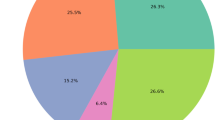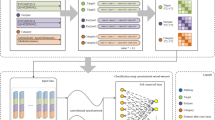Abstract
The aim of this paper is to develop a system for drug–target interaction prediction using artificial intelligence which involves development of both machine learning and deep learning-based systems. In this paper, we use a convolutional neural network (CNN) model, to classify drug–target interactions between drug pairs. Applied to the DDI-Corpus dataset, the single CNN model achieve performance with an F1-score of 0.82 ± 0.012 for the single model and 0.81 ± 0.015 for the ensemble model using deep learning-based CNN with an approved accuracy of 96.72% which is an extra-ordinary achievement. This work has also been performed using the machine learning-based classifiers support vector machine (SVM). For machine learning-based implementation, drug-bank dataset was used for the training and testing. The main challenge when using machine learning for this purpose is the availability of negative DTI to train on. Training machine learning model, the SVM achieved an area under the ROC curve (AUC) of 0.753 ± 0.006, which taking the difference in computational resources into consideration compares well to the AUC of 0.886 ± 0.010 network-based state-of-the-art approach. We achieved and best accuracy of 93.76% using SVM after testing several times.










Similar content being viewed by others
Change history
10 January 2024
This article has been retracted. Please see the Retraction Notice for more detail: https://doi.org/10.1007/s13204-024-03015-4
References
Alhayani B, Abdallah AA (2020) Manufacturing intelligent Corvus corone module for a secured two way image transmission under WSN. Eng Comput. https://doi.org/10.1108/EC-02-2020-0107
Al-Hayani B, Ilhan H (2020) Efficient cooperative image transmission in one-way multi-hop sensor network. Int J Electr Eng Educ 57(4):321–339
Alhayani BSA, llhan H (2021) Visual sensor intelligent module based image transmission in industrial manufacturing for monitoring and manipulation problems. J Intell Manuf 32:597–610. https://doi.org/10.1007/s10845-020-01590-1
Alhayani B, Abbas ST, Mohammed HJ et al (2021) Intelligent secured two-way image transmission using corvus corone module over WSN. Wireless Pers Commun. https://doi.org/10.1007/s11277-021-08484-2
Athreya AP, Neavin D, Carrillo-Roa T, Skime M, Biernacka J, Frye MA, Rush AJ, Wang L, Binder EB, Iyer RK (2019) Pharmacogenomics-driven prediction of antidepressant treatment outcomes: a machine learning approach with multi-trial replication. Clin Pharmacol Ther 106:855–865
Bzdok D, Meyer-Lindenberg A (2018) Machine learning for precision psychiatry: opportunities and challenges. Biol Psychiatry Cogn Neurosci Neuroimaging 3:223–230
Chang B, Choi Y, Jeon M, Lee J, Han K-M, Kim A, Ham B-J, Kang J (2019) ARPNet: antidepressant response prediction network for major depressive disorder. Genes 10:907
Ching T, Himmelstein DS, Beaulieu-Jones BK, Kalinin AA, Dom BT, Way GP, Ferrero E, Agapow PM, Zietz M, Hoffman MM et al (2018) Opportunities and obstacles for deep learning in biology and medicine. J R Soc Interface 15(141):20170387
Dana D, Gadhiya SV, St Surin LG, Li D, Naaz F, Ali Q, Paka L, Yamin MA, Narayan M, Goldberg ID et al (2018) Deep learning in drug discovery and medicine; scratching the surface. Molecules 23:2384
Davatzikos C (2018) Machine learning in neuroimaging: progress and challenges. Neuroimage. https://doi.org/10.1016/j.neuroimage.2018.10.003
C Elkan, ZC Lipton, DC Kale, R Wetzell (2016) Learning to diagnose with LSTM recurrent neural networks. ICLR
Gandal MJ, Leppa V, Won H, Parikshak NN, Geschwind DH (2016) The road to precision psychiatry: translating genetics into disease mechanisms. Nat Neurosci 19:1397–1407
F Gers, J Schmidhuber (2000) Recurrent nets that time and count. Proceeding IEEEINNS-ENNS International Joint Conferences on Neural Networks, 3:189–194
Grapov D, Fahrmann J, Wanichthanarak K, Khoomrung S (2018) Rise of deep learning for genomic, proteomic, and metabolomic data integration in precision medicine. OMICS 22:630–636
Graves A (2013) Generating sequences with recurrent neural networks. Arxiv preprint
Graves A, Schmidhuber J (2005) Framewise phoneme classification with bidirectional LSTM and other neural network architectures. IEEE Trans Neural Networks 18(5):602–610
Hasan HS, Alhayani B et al (2021) Novel unilateral dental expander appliance (udex): a compound innovative materials. Comput Mater Contin 68(3):3499–3511. https://doi.org/10.32604/cmc.2021.015968
Hochreiter S, Schmidhuber J (1997) Long short-term memory. Neural Comput 9:1735–1780
Iniesta R, Stahl D, McGuffin P (2016) Machine learning, statistical learning and the future of biological research in psychiatry. Psychol Med 46:2455–2465
Johnson MJ, Willsky AS (2013) Bayesian nonparametric hidden semi-Markov models. J Mach Learn Res 14:673–701
Kingma DP, Ba JA (2015) Adam: a Method for Stochastic Optimization. International Conference on Learning Representations, 1–13
Kwekha-Rashid AS, Abduljabbar HN, Alhayani B (2021) Coronavirus disease (COVID-19) cases analysis using machine-learning applications. Appl Nanosci. https://doi.org/10.1007/s13204-021-01868-7
Lane HY, Tsai GE, Lin E (2012) Assessing gene-gene interactions in pharmacogenomics. Mol Diagn 16:15–27
Lin E, Lane HY (2015) Genome-wide association studies in pharmacogenomics of antidepressants. Pharmacogenomics 16:555–566
Lin E, Lane HY (2017) Machine learning and systems genomics approaches for multi-omics data. Biomark Res 5:2
Lin E, Tsai SJ (2016) Genome-wide microarray analysis of gene expression profiling in major depression and antidepressant therapy. Prog Neuropsychopharmacol Biol Psychiatry 64:334–340
Lin E, Hwang Y, Liang KH, Chen EY (2007) Pattern-recognition techniques with haplotype analysis in pharmacogenomics. Pharmacogenomics 8:75–83
Linderman S, Adams R (2014) Discovering latent network structure in point process data. In ICML, pp 1413–1421
Litjens G, Kooi T, Bejnordi BE, Setio AAA, Ciompi F, Ghafoorian M, van der Laak J, van Ginneken B, Sanchez CI (2017) A survey on deep learning in medical image analysis. Med Image Anal 42:60–88
Liu T, Jiang J, Li Y, Zhang L (2016) Hashtag recommendation with topical attention-based LSTM. Proceedings of the 26th International Conference on Computational Linguistics
Maciukiewicz M, Marshe VS, Hauschild AC, Foster JA, Rotzinger S, Kennedy JL, Kennedy SH, Muller DJ, Geraci J (2018) GWAS-based machine learning approach to predict duloxetine response in major depressive disorder. J Psychiatr Res 99:62–68
Mikolov T, Karafiat M, Burget L, Cernocky J, Khudanpur S (2010) Recurrent neural network-based language model. Proceedings of Interspeech, pp 1413–1421
Tibshirani R (1997) The lasso method for variable selection in the Cox model. Stat Med 16:385–395
Torres EB, Isenhower RW, Nguyen J, Whyatt C, Nurnberger JI, Jose JV, Silverstein SM, Papathomas TV, Sage J, Cole J (2016) Toward precision psychiatry: statistical platform for the personalized characterization of natural behaviors. Front Neurol 7:8
Yang B, Yih W, He X, Gao J, Deng L (2015). Embedding entities and relations for learning and inference in knowledge bases. arXiv preprint
Zou H, Zhang HH (2009) On the adaptive elastic-net with a diverging number of parameters. Ann Stat 37:1733–1751
Funding
This study was self-funded.
Author information
Authors and Affiliations
Corresponding author
Ethics declarations
Conflict of interest
All authors declare that they have no conflict of interest.
Additional information
Publisher's Note
Springer Nature remains neutral with regard to jurisdictional claims in published maps and institutional affiliations.
This article has been retracted. Please see the retraction notice for more detail: https://doi.org/10.1007/s13204-024-03015-4
Rights and permissions
Springer Nature or its licensor (e.g. a society or other partner) holds exclusive rights to this article under a publishing agreement with the author(s) or other rightsholder(s); author self-archiving of the accepted manuscript version of this article is solely governed by the terms of such publishing agreement and applicable law.
About this article
Cite this article
Yaseen, B.T., Kurnaz, S. RETRACTED ARTICLE: Drug–target interaction prediction using artificial intelligence. Appl Nanosci 13, 3335–3345 (2023). https://doi.org/10.1007/s13204-021-02000-5
Received:
Accepted:
Published:
Issue Date:
DOI: https://doi.org/10.1007/s13204-021-02000-5




